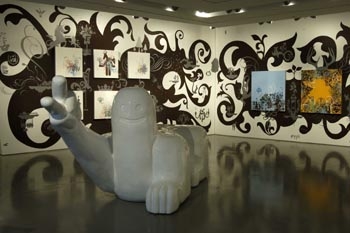
Installation view of Beautiful Losers: Contemporary Art and Street Culture Ryan McGinness, Flocci Non Faccio (2004) installation with panels, brown latex paint and silver vinyl on wall, dimensions variable. Mark Gonzales, Schminx, foam, fiberglass, enamel, approx. 46" x 96" x 108"
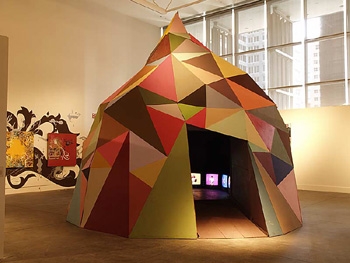
Untitled (2004), Chris Johanson, Wood, paint, DVD monitors; Dimensions variable; Courtesy of the artist and the Jack Hanley Gallery; Photo courtesy of Ira Schrank
Feature: Essays
Marketing the Mission
Commodifying San Francisco’s Art, The “Mission School” and the Problem of Regionalism
Art and politics have always been easy or uneasy bedfellows depending on the economic and cultural conditions of the time. It is clear that capitalism depends on the constant creation of new commodities to be bought and sold in the marketplace. Cultural artifacts like art are commodities that fulfill capitalism’s advance while also often mistakenly appearing to exist as material manifestations of social dissidence. In Marxist theory the appearance of social dissidence keeps the working class in a holding pattern that prevents them from affecting real social revolution. At certain points in history art has been used by social progressives in their revolutionary attempts, at other times it has been used at the service of less ambitious motivations.
In the 1960’s Renato Poggioli defined “avant-garde” as an activity containing innovation, belief in the future and alienation (the artists perceived alienation from the rest of society). Popular understandings of famous European and American avant-garde artists from the late 1800’s to 1960’s form the basis for current public understanding about contemporary artists’ characters and social roles. Like Van Gogh, Picasso, and Warhol, artists are perceived to be rebellious, sensitive, ahead of their time and able to comment on contemporary culture while also living outside the confines of mainstream society. Until recent decades, the term avant-garde (originally a French military term) was most often used to describe art activities that hold the potential for revolution. Today, despite rumblings of future trouble from increased corporate power, a complete social revolution seems unnecessary and unlikely to most Americans who enjoy a historically high standard of living. In this context the value of the idea of an avant-garde is primarily a psychosocial one as it allows us to believe in the possibility of social change. In reality, the real avant-garde, a force that holds the potential to unite art with life, is in danger of being completely usurped by the marketplace. We are encouraged to shy away from overtly political works in favor of “avant-garde” developments that are easily purchased, easily discussed and are consequently mostly abstract and formal in nature. In contrast, the closest thing to a new avant-garde is not in art at all but may be growing in savvy youth movements that protest international trade and global corporate culture through organized protests and culture jamming activities. These protest groups attempt to use the master’s tools to dismantle the master’s house by using public media to broadcast their images and activities to the rest of the world.
However, if we believe that artistic practice is distinct from other kinds of commodity-producing activities, and that this practice can positively influence our culture, then we must resolutely hold ourselves accountable for our actions. This self-critical assessment is the only hope for distinguishing our practice from the rest of the global economy in which value is simply and effectively determined by sales. Today more than ever the relative merit of an artwork results from a complicated network of validations and assessments that are as diverse as they are difficult to agree upon. Often times the very categorization of one object or phenomena as art compared to non-art is in question and only through the capacity of dialogue, rhetoric and/or criticism can the question even hope to be resolved.
Today, in the United States, there is no shortage of artwork. There are currently over 200 MFA programs graduating over ten thousand artists annually. From this expanse of work certain artists are singled out for attention through the “artworld”—an elaborate network of institutions, publications, media outlets and individuals that naturally coalesce around the economic benefits of agreeing on the significance of certain works/artists. Over time, the artworld organically develops new strategies of corralling ‘significant’ works from the bulk of work created. The most recent manifestation of this is the rapid acceleration of artist-as-curator. Curators who are independent of institutional affiliation have become increasingly important in contextualizing artists’ work inside their own creative practice. Individual artworks become less important than the overall theme of the exhibition, which becomes more and more spectacular as curators compete for market share with other forms of entertainment. As in Hollywood, it is more important who you work with than what you actually did and certain curators can make artists careers regardless of the quality of those artists work. Other methods of signaling market importance include gallery sales, participation in specific survey exhibitions, reviews by critically acclaimed writers, international exposure, New York and Los Angeles exhibitions, winning specific awards, etc. These contexts determine which artists will come before the public to be seen and ultimately assessed through some form of visual contact.
Over the recent decades the importance of the artworld as an arbiter of artistic excellence has increased in tandem with the proliferation of media and information technologies used to support it. Ironically, as the world celebrates San Francisco as an economic success and center of media and technological development few of our artists are known nationally or internationally. The history and location of the city, a plethora of significant art schools, a range of galleries and organizations and many other factors continue to attract a diverse group of artists from all over the world despite the high cost of living. Works by these artists are of excellent quality and are as diverse as the places they come from. What keeps the international artworld from seeing the full range of their expression?
Socially and politically, San Francisco has cultivated a variety of opinionated voices that create a dialogue worth listening to, but artistically we have not been as successful. Historically, San Francisco could be considered a role model of an avant-garde city. It has attracted the world’s attention and inspired the world’s imagination for its liberal nature, dissident status and its constant striving for innovation. The city has consistently fostered politicians who make names for themselves nationally through their flamboyant actions. As recently as earlier this year San Francisco mayor Gavin Newsom shocked the nation’s conservatives by authorizing city officials to issue marriage licenses to gay and lesbian couples. Being seen as having a distinct point view, whether positive or negative, is often the defining characteristic of a successful politician. In the artworld, if we lose our critical voice and it is difficult to tell artworks from non-artworks, the only definable exchange may be an economic one.
Unfortunately the San Francisco artworld (collectors, patrons, galleries, museums, curators, etc) is not rising to the challenge of creating the economic and critical infrastructure necessary to support the diversity of arts practice here. In fact, diversity is noticeably lacking from the programming of several of San Francisco’s institutions and commercial galleries as group exhibitions consistently exclude women and artists of color. Rather than signaling an equitable and critical post-feminist artworld, this lack of diversity better represents the stubborn and insular vision of a few men in positions of power. More than ever it is important to question the value being placed on some works chosen over others and to critique the social and political economy that leads to these choices.
San Francisco has no major art magazine, one major newspaper and a handful of online journals and weekly newspapers. Because most of these forums are aimed at a regional audience they are not suitable training ground for young writers who want to examine artwork in a national or international context. In fact, one local journal expressly discourages negative reviews of art exhibitions in its guidelines for writers, asking them to concentrate on ‘good’ work instead. Without constructive criticism, artists and curators are not questioned publicly about the validity of their work. There is a bias towards painting and photography in commercial exhibitions because these objects are easier to sell to the limited number of collectors buying work here. Without the critics to question these biases, the public continues to sees a narrow cross-section of artistic practice. Because of these factors and/or insufficient marketing strategies on the part of galleries and museums, major exhibitions of local artists work are often not reviewed in international publications. As Mark Van Proyen, one of the few opinionated critics in town, asked of other critics in his July 2001 New Art Examiner article, “Where’s the Beef”?
These critical failures are exemplified in an examination of the local artworld’s promotion of “mission school” painting. The first San Francisco artist to gain notoriety for this kind of work was Barry McGee ("Twist") who began his own art practice in the early 1990’s through his involvement with local and national graffiti communities. Since then many artists have been promoted as belonging to the "Mission School": Alicia McCarthy, Margaret Kilgallen, Chris Johanson and more recently Clare Rojas. With the exception of McGee, all of these artists’ work clearly references American folk art traditions such as mural painting, tramp art, sign painting and "outsider" art from the late eighteenth and nineteenth centuries. These artists are consistently marketed through curatorial statements and local reviews as being "outsider artists," with "grass roots" origins who come from the "fringes of society" and who are inspired by graffiti and skateboarding. All one has to do is look past the rhetoric at the artwork to see that in many cases this is simply not true. The very idea of an outsider is problematic and naively nostalgic—it assumes you are outside of something, presumably the artworld. In fact, most of these artists were educated in private art schools—and those that weren’t didn’t learn in a vacuum, they learned from the community of artists they were later marketed to be a part of.
The international success of distinctive artists like these could have been and could still be used as a springboard for promoting many more examples of artistic excellence in the Bay Area. We have an opportunity to market this work as distinctive to our region while critically examining the work in an expanded context—seeing how something made in San Francisco might effect or be affected by the rest of the country and our collective histories. Curators and critics who manufacture "outsider artists" in the United States, when the media-information age makes it practically impossible for any to exist, shamelessly profit from the public’s romantic desire to believe in avant-garde stereotypes like Vincent Van Gogh and Andy Warhol. It might be more interesting to ask why a generation of young sophisticated artists feel compelled to reintroduce narrative and illustrative folk painting into a mainstream world saturated with slick and impersonal packaging.
Ironically in 2004, the artists—always smarter than we give them credit for—have satirized the packaging of their own success in recent works they’ve created. The last (but presumably not least) exhibition on the subject, Beautiful Losers, curated by Aaron Rose and Christian Strike, is currently on view at Yerba Buena Center for the Arts. Chris Johanson’s sculpture and video installation of a utopian folksy drumming circle pokes fun at the hippy stereotype we have come to expect from ourselves and Barry McGee and Josh Lazcano’s mechanical graffiti artists are effective cyborg stand-ins for a once-lively art form that has literally been marketed to death. It should be noted that despite the excellence of some works in this show the exhibition itself is an embarrassing indulgence on the part of the curators, perfectly represented in the tiring work of Terry Richardson—a middle aged man who exhibits portraits of himself posing with young naked women. An extraordinary number of artists in this exhibition have successful commercial design businesses and/or have worked for major fashion and lifestyle magazines. By suggesting that work like this is on the "fringes of society," they are linking this work to a history of the avant-garde, which implies that the work has social relevance born outside of mainstream culture. For a majority of work included in this exhibition, this link is tenuous at best.
This example serves as an illustration of the great disservice we do to our art communities by creating and then consistently promoting a caricature of ourselves. This may make good business sense for tourism in the short term but will do nothing for our long-term viability as a serious art center.
We continue to lose great visual artists as our drive to define ourselves as one simple thing neglects the full range of diversity that creates really great national talent. As it stands now, we continue to lose our best young artists and not because of the high cost of living. Liz Cohen, Eamon Ore-Giron, Lee Walton, Tino Rodriguez, Geoff Chadsey and many more have left over the last few years because their work was not critically appraised and/or was passed over in favor of more stereotypically "San Franciscan" artists. Playing a greater global role artistically means encouraging curatorial projects that actively push local artists’ work beyond regional concerns and locate them in international contexts. In creating, reviewing and discussing local exhibitions, San Francisco’s critical writing should aspire to be worthy of existing as exemplary work in it’s own right. These critiques can function as marketing tools used to promote artwork that does not conform to market saturated recipes of commercial success. After a critical infrastructure is built strong enough to generate and sustain international interest, it is more likely that an economic one will follow.

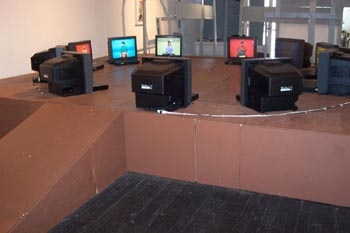
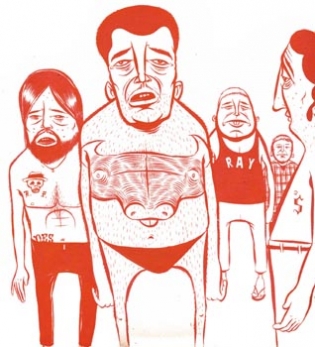
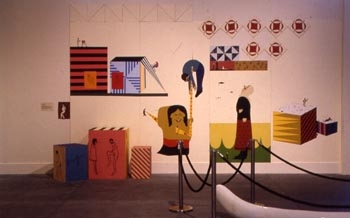
This is one of the most insightful and articulate essays I’ve read addressing the strengths and self-sabotaging addictions of the “art-world” here in San Francisco. Advocating for the growth of a rich, diverse and globally-minded art community here is exactly the sort of thing we need, everyone speaking honestly and directly to one another, producing a synergy that results in better and better art. If Leah Modigliani reads this, I’d invite her to give me a call at my gallery (regardless of what she thinks of our artists - I’m sure she’ll be candid). I know a number of highly motivated and sympathetic people willing to volunteer time and energy towards the fruition of her idealistic and realistic vision for our future; elevating not only the substantial quality and quantity of art here, preventing the “brain-drain” and reversing it, creating a nexus for major art-historical achievements that will ultimately elevate the international perception of San Francisco as the world’s finest destination to explore contemporary fine art.
Raman Frey • February 26, 2005